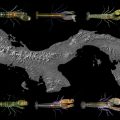By John Barrat
A new Smithsonian study that examines 10 million years of the evolution of tiny coral-like organisms called cupuladriid bryzoans has revealed that some species of this organism lingered on earth for more than one million years after the event that ultimately caused their extinction: the rising of the Isthmus of Panama. The extremely long period that elapsed between the rising of the isthmus and the actual disappearance of these animals is causing scientists to reassess the eventual impact modern habitat loss and environmental degradation may have on organisms whose populations have been reduced and are currently under stress.
Following the rise of the Isthmus of Panama four million years ago—a volcanic event which shut off the flow of nutrient-rich water from the Pacific into the southwestern Caribbean—certain species of cupuladriid bryzoans living in the Caribbean showed a swift drop in population, yet they lingered for another 1 to 2 million years before they eventually became extinct.
Aaron O’Dea and Jeremy Jackson, paleocologists at the Smithsonian Tropical Research Institute in Panama, made their discovery through long-term study of the cupuladriid shells found in geologic deposits on both sides of the Isthmus of Panama. Cupuladriids grow in small, free-living colonies attached to domed, dime-size shells. New colonies are created both sexually, with larvae, and by cloning, through the regeneration of fragments broken from shells. Although similar in appearance to the untrained eye, different cupuladriid species have distinct shell characteristics that allow scientists to identify specific species in the fossil record, track populations over time, and observe how species respond to environmental change and how they reproduce.

Photo: This image shows the front and back of two fossil cupuladriids. The one on top reproduced sexually, and the one on the bottom reproduced by cloning. An outline of the triangular fragment from which the bottom colony regenerated can be seen in the lower right image.
A second discovery made by O’Dea and Jackson was that after the closing of the Isthmus of Panama and the halting of nutrient-rich waters into the Caribbean, the dominant mode of reproduction in Caribbean cupuladriids shifted from asexual cloning to sexual reproduction. Species that were able to change their primary means of reproduction from cloning to sexual survived in the new nutrient-deficient environment of the Caribbean. Those that did not change went extinct. New species of cupuladriid that appeared in the Caribbean during this period reproduced sexually. On the Pacific side of the Isthmus, where the waters remained nutrient rich, cloning remained the dominant mode of reproduction.
The question remains as to why extinction lagged for as long as 1 to 2 million years after the Pacific currents were cut off from the Caribbean and the reproductive productivity of certain cupuladriid species declined, O’Dea and Jackson write in their report, published recently in the Proceedings of the Royal Society B.
“Significant differences in the patterns of abundance between species that went extinct and those that survived provide an important clue.” Species that survived maintained or increased their numbers immediately following the rise of the Isthmus of Panama, the scientists point out. “Most extinct species declined dramatically during this same time.”







